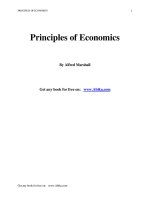Principles of economics openstax chapter16
Bạn đang xem bản rút gọn của tài liệu. Xem và tải ngay bản đầy đủ của tài liệu tại đây (261.48 KB, 21 trang )
+
Information, Risk, and
Insurance
Chapter 16
+
Chapter Outline
n
The Problem of Imperfect Information and Asymmetric
Information
n
Insurance and Imperfect Information
+
Imperfect information and
asymmetric information
n
Asymmetric information: where both parties involved in an
economic transaction have an unequal amount of information (one
party knows much more than the other)
n
n
E.g. Buying a used car
Imperfect information: either the buyer, the seller, or both, are
less than 100% certain about the qualities of what is being bought
and sold
+
Imperfect vs asymmetric
Imperfect Information
Asymmetric Information
n
buyers and/or sellers do
not have all of the
necessary information to
make an informed decision
about the price or quality of
a product
n
one party, either the buyer
or the seller, has more
information about the
quality or price of the
product than the other
party.
n
“Lacking”
n
“Unequal”
+
Lemons – Used Car Market
n even
with imperfect information, prices still
reflect information
n used
cars are more expensive on some dealer
lots because the dealers have a trustworthy
reputation to uphold (signal)
n individual
seller has no reputation to defend
(Craigslist)
+
Imperfect information – Labor
markets
n
How can a potential employer screen for certain attributes, such
as motivation, timeliness, ability to get along with others, and so
on?
1.
Trade schools and colleges to pre-screen candidates.
2.
Only interview a candidate with a degree and, sometimes, a
degree from a particular school.
3.
View awards, a high grade point average, and other accolades
as a signal of hard work, perseverance, and ability.
4.
References for insights into key attributes such as energy level,
work ethic, and so on.
+
Imperfect information - impacts
n Equilibrium
Price and Quantity
n Thin
markets (few buyers and sellers) as each is
hesitant due to uncertainty as opposed to thick
markets (many buyers and sellers)
n Price
as a signal of quality
n E.g. Expensive
restaurants
+
Imperfect Information - Fixing
n Product
n
Reputation, guarantees, warrantees, and service contracts
n Guarantees assure quality (promised)
n Warranty – promise to fix defect over a limited time
n Service Contract – pay extra to assure repairs
n Labor
n
quality assurance
Markets
occupational licenses and certifications to assure competency;
probationary periods
n Financial
n
n
Markets
cosigners and collateral
Federal Trade Commission – against advertisers making false
claims as truth
+ Insurance and Imperfect
Information
Section 16.2
+
Insurance
n
Insurance: a method that households and firms use to prevent any
single event from having a significant detrimental financial effect.
n
Premiums: Regular payments made by households or firms with
insurance
n
Based on probability of event occurring
Pooled and paid out to those affected by the covered event if it occurs
n
E.g. Health insurance, Life insurance, Auto insurance etc.
n
+
How insurance works
n
100 people insured; three risk groups; three possible outcomes
n
Total damage = (60 × $100) + (30 × $1,000) + (10 × $15,000)
= $600 + $30,000 + $150,000
= $186,000
n
If each of the 100 drivers pays a premium of $1,860 each year, the
insurance company will collect the $186,000 needed to cover the
costs of the accidents that occur. Average premiums and average
insurance payouts must be approximately equal.
n
approximately equal.
+
How insurance works
n Risk
group: a group that shares roughly the same risks
of an adverse event occurring.
n Insurance
companies often classify people into risk
groups, and charge lower premiums to those with
lower risks
n If
could classify people according to risk group,
then each group can be charged according to its
expected losses – high risk, pay higher premiums
+
Imperfect information in insurance
markets
n
Moral Hazard : when people engage in riskier behavior with
insurance than they would if they did not have the insurance.
n
E.g. with car insurance, drivers drive less careful than without
n
Cannot be eliminated, but insurance companies can attempt to
reduce it:
1.
2.
3.
4.
n
Monitor behavior to manage risk – security system lowers premiums
Deductibles - amount that the insurance policyholder must pay out of
their own pocket before the insurance coverage starts paying
Copayment - policyholder must pay a small amount
Coinsurance - insurance company covers a certain percentage of the
cost
When faced with copays and deductibles, studies find reduction in
moral hazard (less consumption of covered service)
+
Moral Hazard – health insurance
n
Fee – for – service: medical care providers are paid for the
services they provide and are paid more if they provide
additional services.
n
n
n
Traditional way of providing health care in the US
Lately more shift to health maintenance organizations (HMOs)
Health Maintenance Organization (HMO) provides
healthcare that receives a fixed amount per person enrolled
in the plan—regardless of how many services are provided
n
Consumer still has incentive to demand more services; provider
has incentive to limit it.
+
Adverse Selection
n
Adverse selection - the problem in which the buyers of
insurance have more information about whether they are highrisk or low-risk than the insurance company does.
n
Asymmetric information problem for insurers
n
E.g. With $1860 premium cost from previous example, only high
risk group will get insurance (expected loss greater than $1850,
while others have expected cost less than $1860, so insurance
company can not pool risk, i.e. take from lower risk and pay to
higher risk
n
May refuse high risk individuals, or offer insurance at very high
rates – as was the case with healthcare in US before 2010
+
Affordable Care Act 2010
n
If insurance premiums are set at actuarially fair levels, people
end up paying an amount that accurately reflects their risk
group, certain people will end up paying a lot or not offer it
to those with pre-existing conditions – not allowed under
ACA
n
High premiums – not all get insurance (adverse selection) –
mandated now (50+ employees must offer insurance)
n
State insurance exchanges – for competition of plans
n
Paid for by higher taxes, annual fees on providers
+
Review Questions
+
Review Questions
n
Q6. What are some of the ways a seller of goods might reassure
a possible buyer who is faced with imperfect information?
n
n
Q7. What are some of the ways a seller of labor (that is,
someone looking for a job) might reassure a possible employer
who is faced with imperfect information?
n
n
Solution: Offering warrantees or a period of time in which to return the
product for a full refund might correct for the buyer’s lack of information.
Solution: The worker may offer to work for a trial period for little or no
wages so that the employer can verify his value before signing a longterm contract.
Q8. What are some of the ways that someone looking for a loan
might reassure a bank that is faced with imperfect information
about whether the loan will be repaid?
n
Solution: People looking for loans typically have to show evidence of a
steady income or the possession of collateral, such as a property owned,
so that the bank can be assured of collecting on its loan.
+
Review Questions
n
Q 11. What is an actuarially fair insurance policy?
n
n
Q 12. What is the problem of moral hazard?
n
n
Solution: An actuarially fair policy is one in which the average benefits
paid out equal the average cost to the policy holder.
Solution: Moral hazard is the observation that people behave in more
risky ways when the cost of risky behavior is decreased.
Q 13. How can moral hazard lead to insurance being more
costly than was expected?
n
Solution: When people are insured, they engage in more risky
behavior, leading to higher costs for the insurer and thus higher
premiums for the policy holder.
+
Problem - # 24
Imagine that 50-year-old men can be divided into two groups: those
who have a family history of cancer and those who do not. For the
purposes of this example, say that 20% of a group of 1,000 men have a
family history of cancer, and these men have one chance in 50 of dying
in the next year, while the other 80% of men have one chance in 200 of
dying in the next year. The insurance company is selling a policy that
will pay $100,000 to the estate of anyone who dies in the next year.
n
a. If the insurance company were selling life insurance separately to
each group, what would be the actuarially fair premium for each
group?
n
b. If an insurance company were offering life insurance to the entire
group, but could not find out about family cancer histories, what
would be the actuarially fair premium for the group as a whole?
n
c. What will happen to the insurance company if it tries to charge the
actuarially fair premium to the group as a whole rather than to each
group separately?
+
Solution
n
a. For the high risk group, the premium would be the probability
of dying 0.02 times the benefit payment $100,000 = $2,000. For
the low risk group this would be 0.005 x $100,000 = $500.
n
b. We weight the premiums for the two groups by frequency in
the population and add the results together. $2,000 x 0.2 + $500
x 0.8 = $800.
n
c. The high risk group will recognize that they are getting a
good deal, since $800 is less than their actuarially fair rate of
$2,000, so they will enroll in high numbers. Meanwhile, the low
risk group will be less likely to enroll, since the rate is higher
than their actuarially fair rate of $500. This adverse selection
problem will cause the insurance company to either lose money
or have to raise rates still higher.









